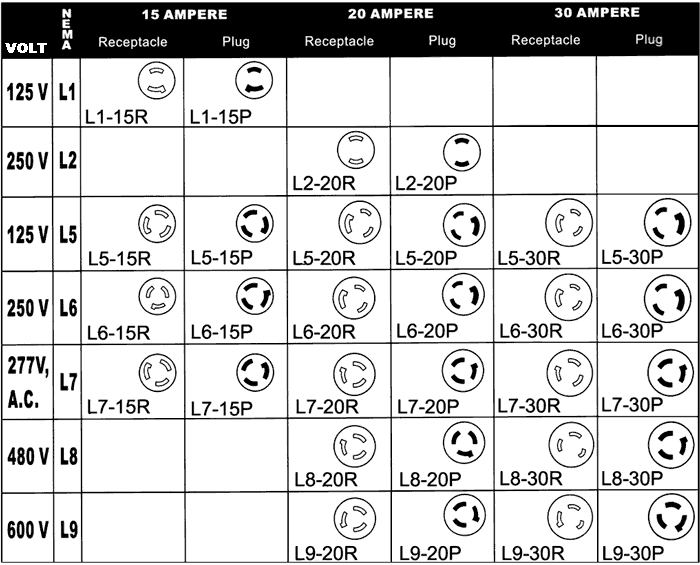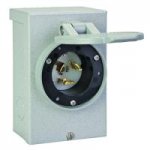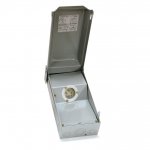Just purchased a variable speed motor (10A max), and decided to completely re-wire from the house to the pool. Old switches and receptacles were rusty, etc and seemed like a good time to upgrade everything. Running 10-gauge wire out to pool inside pvc conduit the entire length. Would like to install a plug end on the pool motor instead of hard-wiring, so I can easily remove pump/motor assy for the winter here in CT. Using a US MOTORS/EMERSON ECOTECH EZ #EVSJ15-NS Variable Speed Motor wired for 230V. Motor only calls for 3-wire connection (L1-black, L2-red, and Ground-Green). However, when I look at 30A and 50A receptacles, appears latest code (after 1996) calls for 4-wire receptacles and plugs for 230V appliances. I have a 4-conductor 10g wiring running from main panel to the GFCI enclosure on the house. Should/can I run 3 wires out to pool (eliminating white wire), install a 3-prong receptacle, and run a 3-prong plug-in from the motor. Or, should I run 4 wires out to pool, install a 4-prong receptacle, use a 4-wire plug on the motor, but just not connect the white wire? Don't want to run 4th wire out to pool, if it's not going to be used, and at cost of copper wire (x 60 ft), seems like a waste, unless req'd by code. And. . . if required by code, why isn't a brand new VS motor setup for a 4-wire connection? I am obviously mounting everything in weatherproof boxes (was planning to use 30A or 50A weatherproof enclosures from GE designed for outdoor RV hookups or weatherproof generator inlet boxes from Reliance Controls). Hoping some electricians chime in and can lend some guidance. Trying to wire and pick up parts this weekend, so any comments today would be greatly appreciated. Just want to do things correctly. Thanks in advance for your assistance.
Wiring Variable Speed Motor - Using Plug-In Receptacle
- Thread starter KendallB
- Start date
You are using an out of date browser. It may not display this or other websites correctly.
You should upgrade or use an alternative browser.
You should upgrade or use an alternative browser.
depending on the amp requirements of the pump, you should be using an L6-15 (20) (30). The15,20,30 refer to the amp load the receptacle can handle. These are 3 prong 240 volt twistlock receptacles. There is no need for a 4 wire plug as the 240 volt motor does not need a neutral to operate.
I'm right there behind danpik. I've seen plenty of 3 wire 220 plugs. L6-30 is the style you want.


n240sxguy
Well-known member
Make sure you get the waterproof versions of the plug and receptacle. If you are price sensitive like I am, check Amazon and eBay. I got an L6-30R for $9 and a L6-30P for $6 on eBay; non waterproof version for my air compressor.
Sent from my iPhone using Tapatalk
Sent from my iPhone using Tapatalk
Thanks for the prompt replies and suggestions. I just wanted to make sure I didn't need to use a 4-wire setup to meet current code, even though motor only uses 3-wires - that was my main concern. The motor only draws 10A max. Was thinking of using a weatherproof generator Power Inlet Box from Reliance Controls or GE (w/3-prong connector), just to make things easier, even though it might be a few $'s more upfront. It's a well-made product, meant for generator connections. It's "backward" of the conventional wiring setup for pools, but I can also find a molded weatherproof generator cord with end fitting, cut to length, and attach to motor. Does anyone see a problem with going this route? Should protect the connection just as well as "the reverse" L6 receptacle in the box. Please confirm this is an option. . . . . or should I go the conventional route (L6-30R receptacle and matching L6-30P plug connector)?




n240sxguy
Well-known member
Go with the conventional connections. Using that box will have live voltage on the prongs that could be touched. It's used for generator connections because the voltage is going the other direction. You never want exposed prongs that could possibly be energized. If you want a premade product like that box, get an rv hookup box. It will also have a 4 wire connection though. No problem with that, just don't use the 4th wire.
Sent from my iPhone using Tapatalk
Sent from my iPhone using Tapatalk
Right, makes sense. I was looking at RV hookup boxes the other day as well. Was thinking the same thing - if I had to go with a 4-wire connector - just don't use the 4th prong.
jmastron
LifeTime Supporter
Yes, please don't use that generator box; danger! You'd have exposed energized prongs that can kill somebody. That's intended to be used with a transfer switch/breaker, so never energized (other than when the generator cord is plugged into it of course). It's the proper alternative to the equally dangerous use of a double-male extension cord to connect a generator to a house.
You also shouldn't use a 4-prong outlet unless the wiring back to the house is 4-wire -- someone could plug something different in later that expects the neutral to be connected. If you're going to run 3 wires, you really should use an outlet that only presents those 3. If you do run 4 wires from the house, then it would be okay to use a 4-prong plug and only connect the 3 wires.
You may want to consider running 4 wires just so you can connect 120V outlets/loads later if you want. Lights, timers, fountain pumps, general use outlets, etc. Effectively you'd put a subpanel out there, with a double pole breaker for the pump and another 1-2 breakers for the 120V loads. And note that the pump may require a GFCI breaker now if you're rewiring.
The reason for 4-wire outlets/plugs are for appliances like stoves and dryers that have both 240V loads (heaters) and 120V loads (clocks, lights, motors, etc) -- in the past, they used 3-wires and tied the case ground and the 120V neutrals together. In theory this means the case is energized slightly, and this is no longer considered code/safe for new house wiring, where separate ground and neutral are provided. Your pump only has 240V, so doesn't have/need a connection to the neutral.
You also shouldn't use a 4-prong outlet unless the wiring back to the house is 4-wire -- someone could plug something different in later that expects the neutral to be connected. If you're going to run 3 wires, you really should use an outlet that only presents those 3. If you do run 4 wires from the house, then it would be okay to use a 4-prong plug and only connect the 3 wires.
You may want to consider running 4 wires just so you can connect 120V outlets/loads later if you want. Lights, timers, fountain pumps, general use outlets, etc. Effectively you'd put a subpanel out there, with a double pole breaker for the pump and another 1-2 breakers for the 120V loads. And note that the pump may require a GFCI breaker now if you're rewiring.
The reason for 4-wire outlets/plugs are for appliances like stoves and dryers that have both 240V loads (heaters) and 120V loads (clocks, lights, motors, etc) -- in the past, they used 3-wires and tied the case ground and the 120V neutrals together. In theory this means the case is energized slightly, and this is no longer considered code/safe for new house wiring, where separate ground and neutral are provided. Your pump only has 240V, so doesn't have/need a connection to the neutral.
That was exactly the info I needed. Subpanel already mounted to side of house instead of out at filter location (4-wire w/GFCI). Might run 4 wires out to pool as you suggested - makes sense. Thank you.
Thanks. I was actually aware of that and had planned to run an insulated ground. Appreciate all the help!
Thread Status
Hello , This thread has been inactive for over 60 days. New postings here are unlikely to be seen or responded to by other members. For better visibility, consider Starting A New Thread.

